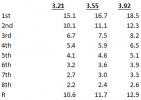About a year ago I purchased a 2020 Ram 1500 with the v6 off the dealer lot. It has the standard 3.21 rear axle, which provides 6400lb tow capacity. That was fine at the time. Now I'm looking at occasionally (2-3 times per year) towing some bigger stuff and would like more tow capacity.
I've shopped around to change out my truck for the Hemi but this market is just brutal. Different dealers have now quoted me between $12,000-18,000 MORE than I paid one year ago to get the exact same truck but with the v8. It's the supply-chain stuff and I get it. But I'm not paying that.
I have seen forum posts about changing the axle ratio and would like to know more information. I understand that in "normal" times it wouldn't be worth it due to cost but it's now an appealing option in this market. My truck is the 4x4, so I believe that I need to change both of the front and rear axles.
I called a few dealers to inquire but this is not a common request so they're all a bit stumped on exactly what parts I need. Can anyone point me in the right direction?
I've shopped around to change out my truck for the Hemi but this market is just brutal. Different dealers have now quoted me between $12,000-18,000 MORE than I paid one year ago to get the exact same truck but with the v8. It's the supply-chain stuff and I get it. But I'm not paying that.
I have seen forum posts about changing the axle ratio and would like to know more information. I understand that in "normal" times it wouldn't be worth it due to cost but it's now an appealing option in this market. My truck is the 4x4, so I believe that I need to change both of the front and rear axles.
I called a few dealers to inquire but this is not a common request so they're all a bit stumped on exactly what parts I need. Can anyone point me in the right direction?
Last edited:












